Bayezid I
Bayezid I (Ottoman Turkish: بايزيد اول, Turkish: I. Bayezid, nicknamed Yıldırım, Ottoman Turkish: یلدیرم, "Lightning, Thunderbolt", often "Bajazet"; c. 1360 – 8 March 1403)[1] was the Ottoman Sultan from 1389 to 1402. He was the son of Murad I[2][3] and Gülçiçek Hatun. He built one of the largest armies in the known world at the time and unsuccessfully besieged Constantinople. He adopted the title of Sultan-i Rûm, Rûm being an old Islamic name for the Roman Empire.[4] He decisively defeated the Crusaders at Nicopolis (in modern Bulgaria) in 1396, and was himself defeated and captured by Timur at the Battle of Ankara in 1402 and died in captivity in March 1403, triggering the Ottoman Interregnum.
| Bayezid I بايزيد اول | |||||
|---|---|---|---|---|---|
| Sultan-ı İklîm-i Rum Khan | |||||
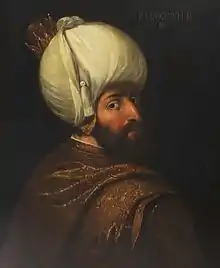 Portrait of Bayezid I | |||||
| 4th Sultan of the Ottoman Empire | |||||
| Reign | 16 June 1389 ‒ 20 July 1402 | ||||
| Predecessor | Murad I | ||||
| Successor | Interregnum (1402 – 1413) Mehmed I | ||||
| Born | c. 1360 Ottoman Beylik | ||||
| Died | 8 March 1403 (aged 42) Akşehir, then under Timurid occupation | ||||
| Burial | |||||
| Consorts | Sultan Hatun Devlet Hatun Hafsa Hatun Despina Hatun | ||||
| Issue | See below | ||||
| |||||
| Dynasty | Ottoman | ||||
| Father | Murad I | ||||
| Mother | Gülçiçek Hatun | ||||
| Religion | Sunni Islam | ||||
| Tughra |  | ||||
Biography
Bayezid’s first major role was as governor of Kütahya, a city thath he earned by marrying the daughter of Germiyanid ruler.[5] He was an impetuous soldier, earning the nickname "Lightning" in a battle against the Karamanids.
Bayezid ascended to the throne following the death of his father Murad I, who was killed by Serbian knight Miloš Obilić during (15 June), or immediately after (16 June), the Battle of Kosovo in 1389, the battle in which Serbia became a vassal of the Ottoman Sultanate. Immediately after obtaining the throne, he had his younger brother strangled to avoid a plot. In 1390, Bayezid took as a wife Princess Olivera Despina, the daughter of Prince Lazar of Serbia,[6] who also lost his life in Kosovo. Bayezid recognized Stefan Lazarević, the son of Lazar, as the new Serbian leader - later despot - with considerable autonomy.
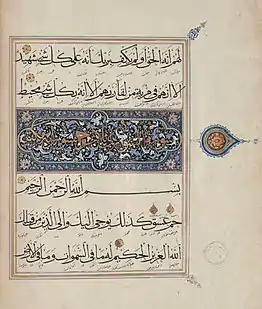
Upper Serbia resisted the Ottomans until General Pasha Yiğit Bey captured Skopje in 1391, converting the city into an important base of operations.
Efforts to unify Anatolia
Meanwhile, the sultan began unifying Anatolia under his rule. Forcible expansion into Muslim territories could have endangered the Ottoman relationship with the gazis, who were an important source of warriors for this ruling house on the European frontier. Thus Bayezid began the practice of first securing fatwas, or legal rulings from Islamic scholars, to justify wars against these Muslim states. However Bayezid suspected the loyalty of his Muslim Turkoman followers, for relied heavily on his Serbian and Byzantine vassal troops in these conquests.[7]
In a single campaign over the summer and fall of 1390, Bayezid conquered the beyliks of Aydin, Saruhan and Menteshe. His major rival Sulayman, the emir of Karaman, responded by allying himself with the ruler of Sivas, Kadi Burhan al-Din and the remaining Turkish beyliks. Nevertheless, Bayezid pushed on and overwhelmed the remaining beyliks -- Hamid, Teke, and Germiyan—as well as taking the cities of Akşehir and Niğde, as well as their capital Konya from the Karaman. At this point, Bayezid accepted peace proposals from Karaman (1391), concerned that further advances would antagonize his Turkoman followers and lead them to ally with Kadi Burhan al-Din. Once peace had been made with Karaman, Bayezid moved north against Kastamonu which had given refuge to many fleeing from his forces, and conquered both that city as well as Sinop.[8] However, his subsequent campaign was stopped by Burhan al-Din at the Battle of Kırkdilim.
From 1389 to 1395 he conquered Bulgaria and northern Greece. In 1394 Bayezid crossed the River Danube to attack Wallachia, ruled at that time by Mircea the Elder. The Ottomans were superior in number, but on 10 October 1394 (or 17 May 1395), in the Battle of Rovine, on forested and swampy terrain, the Wallachians won the fierce battle and prevented Bayezid's army from advancing beyond the Danube.[9]
In 1394, Bayezid laid siege to Constantinople,[10] the capital of the Byzantine Empire. Anadoluhisarı fortress was built between 1393 and 1394 as part of preparations for the Second Ottoman Siege of Constantinople, which took place in 1395. On the urgings of the Byzantine emperor Manuel II Palaeologus a new crusade was organized to defeat him. This proved unsuccessful: in 1396 the Christian allies, under the leadership of the King of Hungary and future Holy Roman Emperor (in 1433) Sigismund, were defeated in the Battle of Nicopolis. Bayezid built the magnificent Ulu Cami in Bursa, to celebrate this victory.
Thus the siege of Constantinople continued, lasting until 1402.[11] The beleaguered Byzantines had their reprieve when Bayezid fought the Timurid Empire in the East.[12] At this time, the empire of Bayezid included Thrace (except Constantinople), Macedonia, Bulgaria, and parts of Serbia in Europe. In Asia, his domains extended to the Taurus Mountains. His army was considered one of the best in the Islamic world.
Clash with Timur
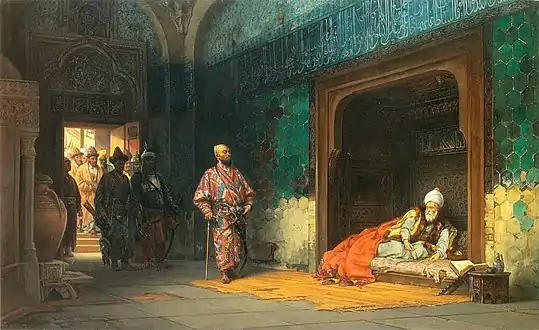

In 1397, Bayezid defeated the emir of Karaman in Akçay, killing him and annexing his territory. In 1398, the sultan conquered the Djanik emirate and the territory of Burhan al-Din, violating the accord with the Turco-Mongol warlord Timur. Finally, Bayezid occupied Elbistan and Malatya.
In 1400, Timur succeeded in rousing the local Turkic beyliks who had been vassals of the Ottomans to join him in his attack on Bayezid, who was also considered one of the most powerful rulers in the Muslim world during that period. Years of insulting letters had passed between Timur and Bayezid. Both rulers insulted each other in their own way while Timur preferred to undermine Bayezid's position as a ruler and play down the significance of his military successes.
This is the excerpt from one of Timur's letters addressed to Ottoman sultan:
Believe me, you are but pismire ant: don't seek to fight the elephants for they'll crush you under their feet. Shall a petty prince such as you are contend with us? But your rodomontades (braggadocio) are not extraordinary; for a Turcoman never spake with judgement. If you don't follow our counsels you will regret it.[13]
In the fateful Battle of Ankara, on 20 July 1402, the Ottoman army was defeated. Bayazid tried to escape, but was captured and taken to Timur.[14] Historians describe their first meeting as follows:
When Timur saw Bayezid, he laughed. Bayezid, offended by this laugh, told Timur that it was indecent to laugh at misfortune; to which Timur replied: “It is clear then that fate does not value power and possession of vast lands if it distributes them to cripples: to you, the crooked, and to me, the lame.”[15]
Many writers claim that Bayezid was mistreated by the Timurids. However, writers and historians from Timur's own court reported that Bayezid was treated well, and that Timur even mourned his death.[16] One of Bayezid's sons, Mustafa Çelebi, was captured with him and held captive in Samarkand until 1405.
Four of Bayezid's sons, specifically Süleyman Çelebi, İsa Çelebi, Mehmed Çelebi, and Musa Çelebi, however, escaped from the battlefield and later started a civil war for the Ottoman throne known as the Ottoman Interregnum.[17] After Mehmed's victory, his coronation as Mehmed I, and the death of all four but Mehmed, Bayezid's other son Mustafa Çelebi emerged from hiding and began two failed rebellions against his brother Mehmed and, after Mehmed's death, his nephew Murad II.
Bayezid in captivity
.jpg.webp)
.png.webp)
In Europe, the legend of Bayazid's humiliation in captivity was very popular. He was allegedly chained, and forced to watch how his beloved wife, Olivera, served Timur at dinner.[18] According to a legend, Timur took Bayezid with himself everywhere in a barred palanquin or cage, humiliating him in various ways, used Bayezid as a support under his legs, and at dinner had him placed under the table where bones were thrown at him.[19]
Different versions on Bayezid's death existed, too. One of them mentioned the suicide of Bayezid.[20] Allegedly, the Sultan committed suicide through hitting the bars of a cell with his head or taking poison. The version was promoted by Ottoman historians: Lutfi Pasha, Ashik Pasha-Zade.[21] There was also a version where Bayezid was supposedly poisoned by Timur's order. This is considered unlikely, because there is evidence that the Turkic ruler entrusted the care of Bayezid to his personal doctors.[20]
In the descriptions of contemporaries and witnesses of the events, neither a cell nor humiliation is mentioned.
German traveller and writer Johann Schiltberger did not write anything about the cell, bars or violent death. Another contemporary, Jean II Le Maingre, who witnessed Bayezid's captivity, wrote nothing about the cell or poisoning as well. Clavijo, who came to Timur's court in 1404 as part of the embassy and visited Constantinople on his return trip, also did not mention the cell. All Greek sources of the first decade of the 15th century are equally silent about the cell.[22] Sharafaddin Yazdi (? -1454) in Zafar-nama wrote that Bayezid was treated with respect, and at his request Turco-Mongols found his son among the captives and brought him to his father. Regarding Bayezid's wife, Sharafaddin wrote that Timur sent her and his daughters to her husband. Olivera allegedly became a Muslim under the influence of Timur.[23]
First references to a disrespectful attitude towards Bayazid appear in the works of ibn Arabshah (1389-1450) and Constantine of Ostrovica. Ibn Arabshah wrote that “Bayezid’s heart was broken to pieces” when he saw that his wives and concubines were serving at a banquet.[24]
Ibn Arabshah wrote the following about the captivity of Bayezid:
“Ibn Usman became a prey and was locked up like a bird in a cage."[25]
However, this is just a “flowery style”, and not a real cell. According to literary historian H.A.R. Gibb, “the flowery elegance of style has also affected historiography. Most of the authors of the Timurid era succumbed to its influence ”.[26]
Constantine of Ostrovica wrote neither about the cell, nor about the nudity of Bayezid's wife; though he did write that Bayezid committed suicide. In the story of Constantine, just like in that of ibn Arabshah, the Sultan was so struck by the fact that his wife carried wine to a feast that he poisoned himself with a poison from his ring.[27]
Ottoman historian Mehmed Neshri (1450-1520) described Bayezid's imprisonment and mentioned the cell twice. According to him, Timur asked Bayezid what he would do in Timur's place with regard to the captive. “I would have planted him in an iron cage,” Bayezid answered. To which Timur replied: "This is a bad answer." He ordered to prepare the cage and the Sultan was put into it.[28]
The complete set of legends may perhaps be found in the work of Pope Pius II Asiae Europaeque elegantissima descriptio, written in 1450-1460 (published in 1509): Bayezid is kept in a cage, fed with garbage under the table, Timur uses Bayezid as a support to get on or off a horse. Further development can be found in later authors, such as Theodore Spandounes. The first version of his story was written in Italian and completed in 1509, and a French translation was published in 1519. In these versions of the text, Spandounes wrote only about the golden chains and that the Sultan was used as a stand. Spandounes added the cell only in later versions of the text. Later versions of the text also include a description of the public humiliation of Bayezid's wife:
“He had a wife of Ildrim, who was also a captive. They ripped off her clothes to the navel, exposing shameful areas. And he (Timur) made her serve food to him and his guests like that.[29]
Family
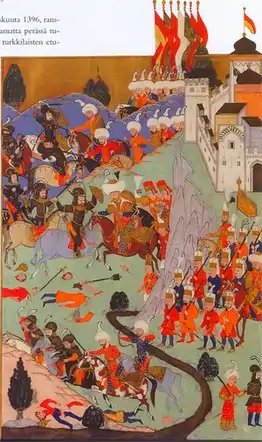
His mother was Gülçiçek Hatun who was of ethnic Greek descent.[2][31]
- Wives and concubines
Bayezid had five consorts
- Sultan Hatun (m. 1381), daughter of Prince Süleyman Şah Çelebi of the Germiyanids and Mutahhare Abide Hatun;[32][33]
- Devlet Hatun, mother of Mehmed I;
- Despina Hatun (m. 1389), daughter of Prince Lazar of Serbia and Princess Miliza;[34][33]
- Hafsa Hatun (m. 1390), daughter of Prince Fahreddin Isa Bey of the Aydinids;[34]
- Sons
- Şehzade Ertuğrul Çelebi; (1378 – 1400)
- Şehzade Süleyman Çelebi (1377 – 1411), sultan of Rumelia, claimant to the Ottoman throne (reign 1402-1411)
- Şehzade İsa Çelebi (1380 – 1406), governor of Anatolia, claimant to the Ottoman throne (reign 1403-1406)
- Şehzade Mehmed Çelebi (1382 – 1421), governor of Anatolia, and later sultan Mehmed I (reign 1413–1421), with Devlet Hatun
- Şehzade Musa Çelebi (1388 – 1413), sultan of Rumelia (1410–1413), claimant to the Ottoman throne (1406-1413)
- Şehzade Mustafa Çelebi (1393 – 1422), sultan of Rumelia, claimant to the Ottoman throne (reign 1419-1422)
- Şehzade Yusuf Çelebi, converted to Christianity, changed his name to Demetrios[35]
- Şehzade Kasım Çelebi, sent as a hostage to Constantinople together with his sister, Fatma Hatun;[35]
- Daughters
- Hundi Hatun, married to Damat Seyyid Şemseddin Mehmed Buhari, Emir Sultan;[36]
- Erhondu Hatun, married to Damat Yakup Bey son of Pars Bey;[36]
- Fatma Hatun, married to a Sanjak Bey;[36]
- Oruz Hatun, who had a daughter named Ayşe Hatun;[36]
- A daughter, married to Abu Bakar Mirza, son of Jalal ud-din Miran Shah son of Timur;
Personality
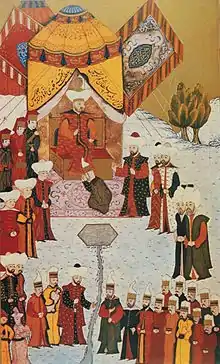
According to the British orientalist, Lord Kinross, Bayezid was distinguished by haste, impulsivity, unpredictability and imprudence.[37] He cared little for state affairs, which he entrusted to his governors. As Kinross writes, between campaigns Bayezid was often engaged in pleasures: gluttony, drunkenness and debauchery. The courtyard of the Sultan was famous for its luxury and was comparable to the Byzantine court during its heyday.[38]
At the same time, the Sultan was a talented commander.[37] In all 13 years of his reign, Bayezid suffered only one defeat, which eventually turned out to be fatal for him.[39] Despite his lust for earthly pleasures, Bayezid was a religious man and used to spend hours in his personal mosque in Bursa. He also kept Islamic theologians in his circle.[40]
Evaluation of rule
Bayezid managed to expand the territory of his empire to the Danube and the Euphrates. However, Sultan's policy led to a humiliating defeat at Ankara and to the collapse of his state. The Ottoman Empire declined to the size of a beylik from the time of Orhan, but even that territory was divided by Timur and given to the two sons of Bayezid. Small beyliks gained independence again thanks to Timur, who wanted to conquer China in the last years of his life, and therefore did not complete the defeat of the Ottomans. The victory at Ankara marked the beginning of the Ottoman interregnum, which lasted 10 years.[14]
In fiction
.jpg.webp)
The defeat of Bayezid became a popular subject for later Western writers, composers, and painters. They embellished the legend that he was taken by Timur to Samarkand with a cast of characters to create an oriental fantasy that has maintained its appeal. Christopher Marlowe's play Tamburlaine the Great was first performed in London in 1587, three years after the formal opening of English-Ottoman trade relations when William Harborne sailed for Constantinople as an agent of the Levant Company.
In 1648, the play Le Gran Tamerlan et Bejezet by Jean Magnon appeared in London, and in 1725, Handel's Tamerlano was first performed and published in London;[41] Vivaldi's version of the story, Bajazet, was written in 1735. Magnon had given Bayezid an intriguing wife and daughter; the Handel and Vivaldi renditions included, as well as Tamerlane and Bayezid and his daughter, a prince of Byzantium and a princess of Trebizond (Trabzon) in a passionate love story. A cycle of paintings in Schloss Eggenberg, near Graz in Austria, translated the theme to a different medium; this was completed in the 1670s shortly before the Ottoman army attacked the Habsburgs in central Europe.[42]
The historical novel The Grand Cham (1921) by Harold Lamb focuses on the quest of its European hero to gain the assistance of Tamerlane in defeating Bayezid.[43] Bayezid (spelled Bayazid) is a central character in the Robert E. Howard story Lord of Samarcand,[44] where he commits suicide at Tamerlane's victory banquet. Bayazid is a main character in the novel The Walls of Byzantium (2013) by James Heneage.[45]
In popular culture
Sultan Bayazit was portrayed in the Serbian 1989 historical drama film Battle of Kosovo, as a participant of the Battle of Kosovo by actor Branislav Lečić, and in the Romanian historical drama Mircea (Proud heritage) by Ion Ritiu as a young Sultan who fought in the battles of Rovine, Nicopolis and Angora.
See also
Notes
- "Bayezid I - Ottoman sultan". britannica.com. Archived from the original on 2 April 2016.
- Lowry, Heath W. (2003) The Nature of the Early Ottoman State. Albany, NY: State University of New York Press, p. 153
- Runciman, Steven The Fall of Constantinople. Cambridge: Cambridge University Press, p. 36
- Peirce, Leslie P. (11 May 1993). The Imperial Harem: Women and Sovereignty in the Ottoman Empire. Oxford University Press. ISBN 9780195086775. Archived from the original on 23 September 2017 – via Google Books.
- Halil Inalcik. "Bayezid I". TDV.
- Halil Inalcik, "Bayezid I", The Encyclopedia of Islam, Vol. I, Ed. H.A.R. Gibb, J.H. Kramers, E. Levi-Provencal and J. Schacht, (Brill, 1986), 1118.
- Stanford Shaw, History of the Ottoman Empire and Modern Turkey (Cambridge: University Press, 1976), vol. 1 p. 30
- Shaw, History of the Ottoman Empire, vol. 1 pp. 30f
- John V.A. Fine, The Late Medieval Balkans, (The University of Michigan Press, 1994), 424.
- Mango, Cyril. The Oxford History of Byzantium. 1st ed. New York: Oxford UP, 2002. p. 273-4
- Nancy Bisaha, Creating East And West: Renaissance Humanists And the Ottoman Turks, (University of Pennsylvania Press, 2004), 98.
- Dimitris J. Kastritsis, The Sons of Bayezid: Empire Building and Representation in the Ottoman Civil War of 1402-13, (Brill, 2007), 5.
- Rhoads Murphey, Exploring Ottoman Sovereignty: Tradition, Image and Practice in the Ottoman Imperial Household 1400-1800; published by Continium, 2008; page-58
- Kinross, B.P; "Ottoman Centuries: The Rise and Fall of the Turkish Empire". 1999. p. 86-88; ISBN 5-232-00732-7
- Ivanin M.I. "On the art of war and the conquests of the Mongol-Tatars and Central Asian peoples under Genghis Khan and Tamerlane". St. Petersburg, 1875. p. 315.
- MESERVE, Margaret (30 June 2009). Empires of Islam in Renaissance Historical Thought. Harvard University Press. ISBN 9780674040953.
- Dimitris J. Kastritsis,1-3.
- Alderson A. D. The Structure of the Ottoman Dynasty. — Oxford: Clarendon Press, 1956.
- Milwright M., Baboula E. Bayezid's Cage: A Re-examination of a Venerable Academic Controversy. Journal of the Royal Asiatic Society. — 2011. — Vol. 21, iss. 3. — p. 243
- Akgunduz A.; Ozturk S. Ottoman History — Misperceptions and Truths. — Rotterdam: IUR Press, 2011. p. 75. ISBN 978-9090261-08-9
- Akgunduz A.; Ozturk S. Ottoman History — Misperceptions and Truths. — Rotterdam: IUR Press, 2011. p. 74. ISBN 978-9090261-08-9
- Milwright M., Baboula E. Bayezid's Cage: A Re-examination of a Venerable Academic Controversy. Journal of the Royal Asiatic Society. — 2011. — Vol. 21, iss. 3. — p. 242
- Sharaf al-Din Ali Yazdi. Zafar-name. Tashkent: SAN'AT, 2008 . p. 519. ISBN 978-9943-322-16-5
- Ibn Arabshah. History of Amir Temur. translated by Bababekova, H. N. Tashkent: Makhpirat Institute of the History of the Peoples of Central Asia, 2007. p.188
- Ibn Arabshah. History of Amir Temur. translated by Bababekova, H. N. Tashkent: Makhpirat Institute of the History of the Peoples of Central Asia, 2007. p.184
- Gibb H. A. R. Muslim historiography. translated by Gryaznevich P. A. Arabic literature. Classical period. ed. Belyaev, V. I. Publishing house of Eastern Literature, 1960. - pp. 117-156. p.188
- Constantine from Ostrovitsa. Notes of the Janissary. Written by Constantine Mikhailovich of Ostrovica. Introduction., translation and comm. by Rogova, A. I. published by Nauka, 1978.- p. 136 (Monuments of the Medieval history of the peoples of Central and Eastern Europe)
- Mehmed Neshri. Bogged down into the light: History on the Ottoman court. ed: Maria Kalitsin. Sofia: Fatherland Front, 1984. p. 420
- Theodore Spandounes. On the Origins of the Ottoman Emperors. transl. and ed. by: Donald M. Nicol. Cambridge: Cambridge University Press, 1997. p. 200
- "Battle of Nicopolis (1396)" from Seyyid Lokman (1588): Hünernâme
- Shaw, History of the Ottoman Empire, Vol. 1 p. 28
- Köprülü, Mehmet Fuat (1966). Edebiyat araştırmaları. Türk Tarih Kurumu Basımevi. p. 76.
- Öztürk, Necdet (30 January 2014). Osmanlı Sosyal Hayati. Işık Yayıncılık Ticaret.
- Uluçay, M. Çağatay (1985). Padişahların kadınları ve kızları. Türk Tarih Kurumu. pp. 24–5.
- Kastritsis (2007, p. 41)
- Mustafa Çağatay Uluçay (2011). Padişahların kadınları ve kızları. Ankara, Ötüken. pp. 25–6.
- Kinross, B.P; "Ottoman Centuries: The Rise and Fall of the Turkish Empire". 1999. p. 70-71; ISBN 5-232-00732-7
- Kinross, B.P; "Ottoman Centuries: The Rise and Fall of the Turkish Empire". 1999. p. 73 ISBN 5-232-00732-7
- Kinross, B.P; "Ottoman Centuries: The Rise and Fall of the Turkish Empire". 1999. p. 82-85; ISBN 5-232-00732-7
- Kinross, B.P; "Ottoman Centuries: The Rise and Fall of the Turkish Empire". 1999. p. 73; ISBN 5-232-00732-7
- London: Printed & sold by J. Cluer, [1725]
- Finkel, C. (2006) The History of the Ottoman Empire: Osman's Dream. New York: Basic Books; p. 30
- Lamb, Harold. Swords from the West. Lincoln; University of Nebraska Press, 2009 ISBN 9780803226203 (p.603)
- Howard, Robert E. (1973) Sowers of the Thunder, Ace Science Fiction
- " The Walls of Byzantium...[where] The Armies of the Ottoman Emperor Bayazid threaten Constantinople and the few remaining outposts of its empire". Cited in "Three More Tales of the Byzantine Empire". BBC History Magazine, 10 September 2015 (p. 74).
Sources
- İnalcık, Halil (1960). "Bāyazīd". In Gibb, H. A. R.; Kramers, J. H.; Lévi-Provençal, E.; Schacht, J.; Lewis, B. & Pellat, Ch. (eds.). The Encyclopaedia of Islam, New Edition, Volume I: A–B. Leiden: E. J. Brill. pp. 1117–1119. OCLC 495469456.
- Harris, Jonathan (2010) The End of Byzantium. New Haven and London: Yale University Press ISBN 978-0-300-11786-8
- Imber, Colin (2009). The Ottoman Empire, 1300-1650: The Structure of Power (2 ed.). New York: Palgrave Macmillan. ISBN 978-0-230-57451-9.
- Kastritsis, Dimitris (2007). The Sons of Bayezid: Empire Building and Representation in the Ottoman Civil War of 1402-13. BRILL. ISBN 978-90-04-15836-8.
- Nicolle, David (1999) Nicopolis 1396: The Last Crusade. Oxford: Osprey Books ISBN 978-1-85532-918-8
External links
| Wikimedia Commons has media related to Bayezid I. |
Bayezid I Born: 1360 Died: 8 March 1403 | ||
| Regnal titles | ||
|---|---|---|
| Preceded by Murad I |
Ottoman Sultan 16 June 1389 – 20 July 1402 |
Succeeded by Mehmed I |
.svg.png.webp)